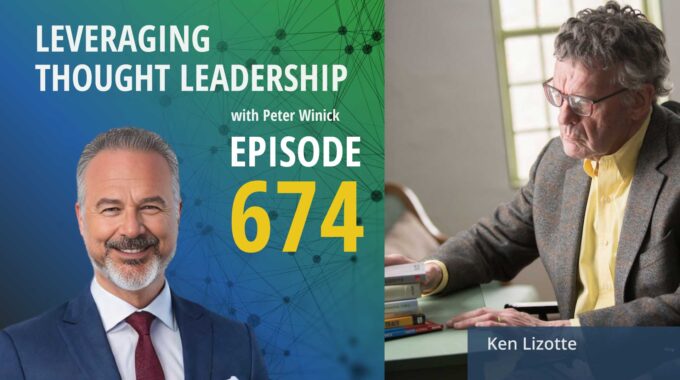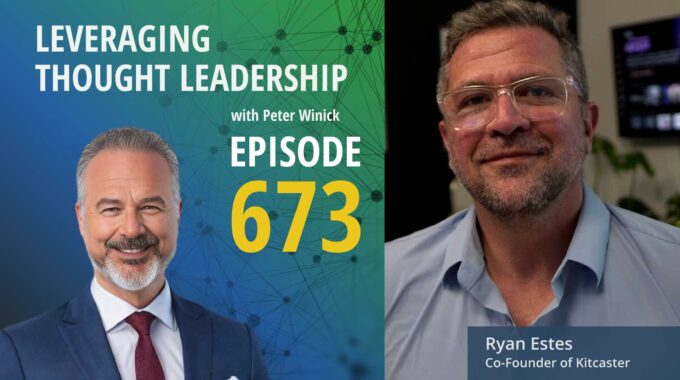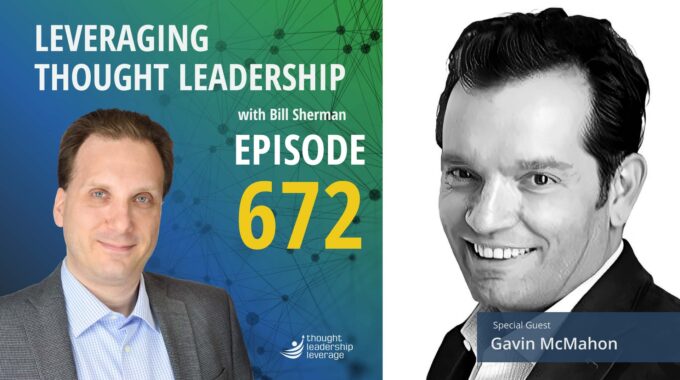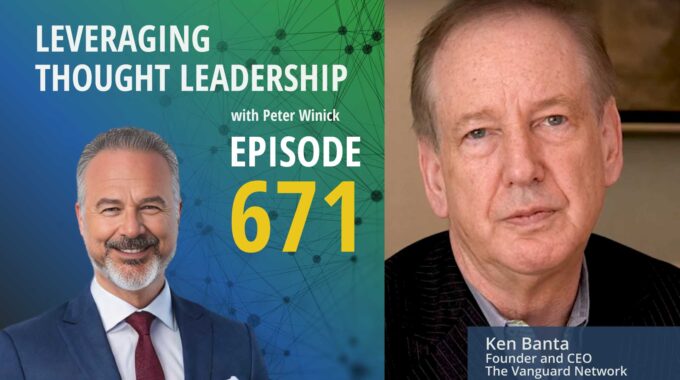Why Great Thought Leaders Don’t Play the Publisher’s Game Peter talks with publishing expert Ken…
Following Instinct in Thought Leadership and Consulting | Maura Barclay
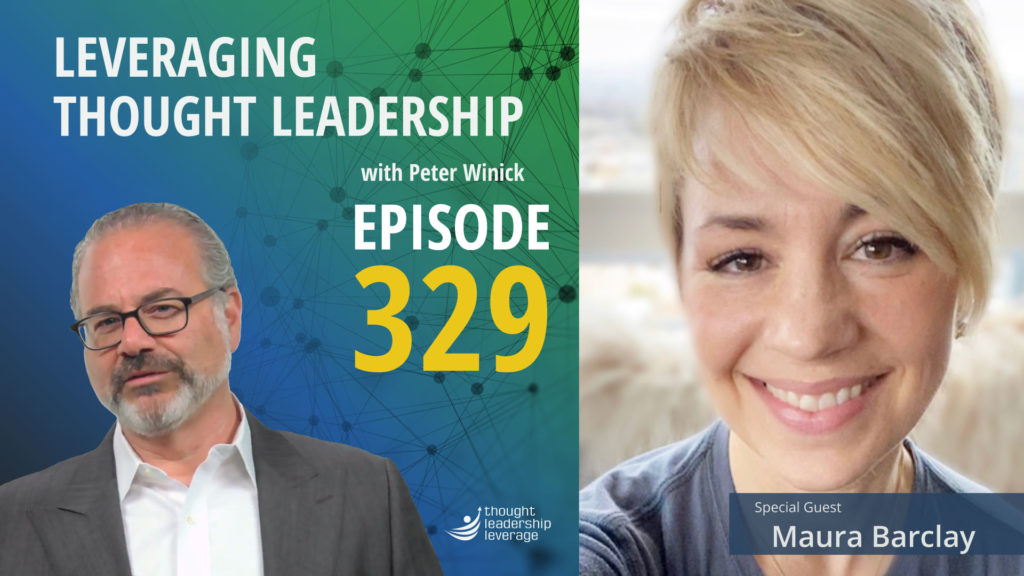
Learning to build and trust your instinct while deploying thought leadership.
An interview with Maura Barclay about instructional design, the physiology of intuition, and how to trust your gut.
Today’s guest is Maura Barclay, a transformational leadership consultant. In addition to being the author of Unbreakable Women, her previous occupations range from firefighter to fitness trainer to military consultant! In this conversation, she shares the ways that her wide variety of previous experiences make her an incredible consultant and coach.
Maura has always been interested in building and relying on proven methodologies that can be repeated for reliable outcomes. Learning is only the beginning; a great leader needs to continue to upgrade and iterate their knowledge into stronger, even more functional methods. In her work, she often utilizes check-lists, setting goals and building methods to achieve more Creating a solid list will anchor the methods in your brain, teaching the instinctive left-brain to perform tasks automatically – and guiding you to greater success.
Maura uses her powerful and proven neurofacilitation system to help people build new mindset pathways. Armed with this tool, a leader can trust their well-trained instincts, and recognize good intuition, thus breaking bad habits and learning productive ones!
If you are tired of second guessing yourself, and want to train your mind to fire all cylinders toward success, this episode has the best tips for you!
Three Key Takeaways:
- Thought Leadership should use a methodology that is reliable, duplicable, and effective.
- Intuition often comes from past experience. Thought leaders can build intuition by creating habits that recognize good instinct, and build on it.
- If you want to sharpen your thought leadership content, spend time ruling out the things on which you don’t focus. What’s left will be your passion!
If you need a strategy to bring your thought leadership to market, Thought Leadership Leverage can assist you! Contact us for more information. In addition, we can help you implement marketing, research, and sales. Let us help you so you can devote yourself to what you do best.
Transcript
Peter Winick And welcome, welcome, welcome, this is Peter Winick, I’m the founder and CEO at Thought Leadership Leverage, and you’re joining us on the podcast today, which is Leveraging Thought Leadership today. My guest is Maura Barclay. She’s an intuitive leadership consultant and neuro facilitation practitioner. She’s written a book called The Unbreakable Woman, and she’s got another one in the pipeline. She’s presented for nearly two decades across the nation for federal agencies, Fortune 500 companies, and the military. Her and I were talking, I think it was last week, and we had a really cool conversation about her journey and her career. So let’s talk about that because that’s sort of an interesting — so what was the logical linear path that you took to — obviously get to be a thought leader?
Mara Barclay Oh, yes. Yes, indeed. This should be college curriculum, my path here. So first you go to school and you get accepted to the journal the J-school School of Journalism, Mass Communication, University of Colorado Boulder with a minor and marketing in Spanish. And the next logical step is to become a firefighter in Boulder, which you did, and worked on the ambulance and served in pre-hospital care for seven years. And what my specialty was medical Spanish and — which I loved. It was just awesome. And then the next step, of course, is to go to L.A. and become an actor, which I did, and that went very well. Got myself some pretty sweet gigs, and I’m still getting residual checks, which is super cool. Sometimes I like to take little photographs of the check, as it says from Warner Brothers and sell them. Yeah, I’m kind of a big deal. So and then I show them that it’s for four dollars and we have a good laugh anyway. So the next logical step from acting was into the mind body space as a master instructor of therapeutic yoga. So I taught teachers how to teach that, and I also taught meditation and embodied anatomy, which is a conscious approach to teaching and using your anatomy.
Peter Winick Mm-Hmm.
Mara Barclay And naturally, I went from there into martial arts as a hobby, primarily until it informed my book Compassionate Self-Defense and Empowerment. When I recognized that what was going on with self-defense for women just really wasn’t organic.
Peter Winick So wait, so 30 seconds ago, we were in bilingual medical Spanish. Right, now I’m I’m just making sure I’m tracking, here. Right. This is what I love about this world, right?
Mara Barclay Yes. You got it. You got it.
Peter Winick OK, I’m going to make sure I didn’t blink. OK, cool. Yeah.
Mara Barclay Don’t blink. You’ll miss a big step that will go somewhere you’ll never expect, including myself. So from there, I presented, as you mentioned, to Fortune 500 companies, Fortune 100 companies, and on the strength of my book, I got hired as a contractor for the U.S. military to help them with their assault prevention program. I got to travel around the world with this incredible team of total birdhouses. And I was like the lone civilian female, but I was there, Smee, so it was such an incredible place to be. The deference that they gave me because of my expertise and yet I’m like, they could kill me with a napkin. We just surrendered to the whole thing. It was awesome. And from there I got cancer and that helped me pivot my mindset. And I recognized how I was living was not what I wanted to be, how I wanted to be living and not want to do what I wanted to be doing. And I pivoted into soulful leadership, and I took my concept and made it a little bit broader a cast, a wider net. And I started a business. Six figures of first year became very successful, and now I’m in the business of coaching coaches, teaching them to let go of their past and feel worthy to receive the future they’re creating.
Peter Winick Cool. So that’s an interesting journey, obviously, right? But now let’s look at the business model. So underneath that, because there’s sort of two threads to that story. There’s the narrative went from A to B to C to D, whatever, with a mild case of whiplash along the way, which is sort of cool. And then there’s the underlying business model so presenting on behalf of the military subject matter, expertise, facilitator, presenter, etc. And now you’re at the place where you’re in essence, licensing, telling whatever the case may be, having a relationship with coaches to use your methodology, framework and such to enhance their product. Right. That’s the thing.
Mara Barclay And it’s all about being relational instead of transactional and about being invitational and value oriented versus the pushing the, you know, the cold calling. I just look, that works for some people, Peter and I love it for them. I don’t like it doesn’t work for me. So when I work with transformational leaders, it’s like they’re crawling through the desert on their knees and I’m the like, I’m the water. They’re just like, Oh my gosh, I’ve been waiting for this.
Peter Winick Got it. So I want to sort of talk about the differences because a lot of thought leaders struggle with this, which is, Hey, I’ve got the domain expertise. I’m doing this a long time. It’s part of my DNA, whatever. So it’s easier for you to get up in front of a group of pretty much anything and do what you do. Now, when you move that business instead of you being the product, but the methodology, the intellectual property, the thought leadership being the product breaking that down to sort of the molecular level, the LEGO pieces, whatever you want to call it, so that others can deliberate, and they may not delivered as well as you or whatever. What was that like for you? Because a lot of people sort of get ganged up on that. That’s not an easy thing to do.
Mara Barclay I totally understand why. This is such a great question, and I’m so glad that we’re covering this territory, Peter, because what you’re asking for is kind of like “What’s a tactical analysis of what you do?” And luckily, I learned how to do that in the fire department. So I’ve always been a curriculum creator. I’ve always been a duplicator —.
Peter Winick Wait, you were in the fire department? I think in your story, you left out the part where you were in the fire — a fire… person.
Mara Barclay Oh? I was a firefighter. Yeah, Boulder fire department and working on the ambulance. Yeah. So I’ve always been kind of a tactician and a practical mystic, and I only work with evidence based practices. I only want methodology that’s duplicate, able and effective for everybody or else there’s no point to anything, in my opinion. So what I’ve done is taken, know, road tested, purpose built tools and practices that I had decades of experience with, and I have adapted them to transformational coaching models. Business model.
Peter Winick So stay there a second, because it feels like and tell me if I’m misreading this, one of the things that you picked up from your firefighting days in the empty days is that is those are two professions that are very much based on tactical knowledge transfer methodology checklists, right? The first time you as a firefighter run into a building. Yes, it’s your first time. The adrenaline is going. The fear is going whatever. But you’ve been trained umpteen times how to scan things, various methodologies. I don’t know that it’s based on that well, but it’s training, training, training, training, training, training so that you’ve got the cumulative sort of knowledge of tens of thousands of firefighter hours with you. That makes sense in that space, right? And in first responders space, people struggle with it more in the leadership space because it’s not as checklist-able, if that’s a word.
Mara Barclay Oh, I love what you’re saying, Peter. And here’s the thing. It absolutely is. If you know the right checklist you use, what you’re talking about is what I would call scene assessment. So the this is part of this is a part of situational awareness. Whether you are on emergency scene, a domestic which is very volatile or you’re walking into a group of people who don’t want to hear your message, but they’ve been volunteered by their lieutenant captain that they have to be there. Or you’re walking into a group of people who are so excited to hear your message doesn’t matter the seat. The assessment of the scene is always the same as far as the tactics, the checking of the boxes. It’s just you change the list every time you go in because the only thing that matters is that your message, lance, or in the case, of course, it’s seen safety that you get your job done and everybody goes home in one piece. And to me, there really is no difference. It’s just a different context with slightly different content, right?
Peter Winick So that’s what I find fascinating about this, because your context is literally life or death, right? If you don’t follow the checklist, you know, whatever the roofs can cave in on you, you can die. Others could get hurt, et cetera, et cetera, et cetera. So you really it was really drilled into you the importance of sort of coming up with following the systems in the models and the methodologies and not necessarily that one individual told you, Oh, this is Mike, here’s my hack to get into a building. No, no, no. There’s best practices that every sort of body right? Every governing body, every fire department report says No, these are the ways that we do things I don’t need you. What we don’t want is more of the creative firewood, right? Like, that’s not a place for a lot of creativity. So moving that discipline into a different domain like leadership, although for you, it’s perfectly logical. Of course, it is right for a lot of people. They don’t get that. They’re like, No, I just figure it out. Or, you know what makes you a great coach? Do you have a model or framework or methodology? No, not really. And I’m like, Actually, you do, but you’ve just never been forced to codify it or document it. Your first session with the client, you’re doing an assessment. No, I’m not. OK, well, tell me what you do. We’ll ask a bunch of questions. OK, and what are you trying to get to right? So they might not have the same language. So there’s really I find that really interesting. And I think one of the least respected disciplines that thought leaders have earlier on in their journey is instructional design, right? So they think, Hey, I’m good at what I do. I could write the book. I can do the keynote. Someone asked me to do a workshop that’s sort of kind of like a long keynote. I’ll just talk for a long time.
Peter Winick If you’re enjoying this episode of Leveraging Thought Leadership, please make sure to subscribe. If you’d like to help spread the word about our podcast, please leave us a review and share it with your friends. We’re available on Apple Podcasts and on all major listening apps, as well as at Thought Leadership Leverage dot com forward slash podcasts.
Peter Winick Tell me sort of give me the difference or what the insights the world of instructional design teaches you.
Mara Barclay Well, I want to. I want to take you on kind of a two pronged journey here, Peter, because. One thing that is very easily overlooked, and this is where I think CEOs and the C-suite in general and senior VP’s at that level, this is where they run into trouble. They discount the value and necessity for intuition. And I can tell you, ask any cop, ask any firefighter. Intuition is as important as the tactical checklist it’s on there. You always check in with yourself if something feels like I forget what they say. Combo Pack It’s not just a combo, exactly, but the thing is in business. Business leaders are not taught to listen to their intuition. They’re like, You’re like, Are you going to tell the shareholders, you have a gut feeling about this? This is the kind of resistant, right? You get it. This is the resistance they’re met with, and it suddenly becomes like a female attribute. I’m like, No, it’s not. It’s a survival attribute. It’s inner wisdom. And there ain’t a bad ass — an observant leader in the military, or anybody who carries a gun, they rely on their spidey senses.
Peter Winick I would say entrepreneurs do that far better, and I’m painting with a broad brush here than your Fortune 1000 middle managers, right? Because nobody wants to hear somebody going to the board meeting. But I had this, you know, I was in the shower and I had this thing. And you know, that’s why we’re going to bet a billion dollars on it. They’re like, Holy crap, right? But if you’re a crazy person like Steve Jobs is, no, I don’t care what the customer thinks because they’ll never describe to me what an iPhone is, right?
Mara Barclay You know, yeah, this is the whole point of innovation. It’s scary because there’s no there. That’s how innovation happens. And I love that you brought this up because, you know, intuition is an anatomical process. There is a physiology. This is what I teach the science of intuition. There is a physiology behind it. It has a checklist just like everything else. And once you get anchored into the physiology, into the science of what’s happening with your intuitive impulses, suddenly it becomes a left-brain thing and you were able to leverage it.
Peter Winick So what happens? So if you’re in a domain for a long time and you have some expertise, I would imagine the intuition develops like a muscle, right? So if I a dentist for 20 years and you walk in and yell, Oh, okay, yeah, I kind of tell from what she sort of kind of said in between the words she probably has a root needs a root canal, right? That’s my intuition now from a first year dental student. Do I really have the right to trust my intuition stuff? And where do those things sort of, you know, balance out?
Mara Barclay Well, you just said the magic word. Everybody gets intuition all the time. It’s not developing intuition. You develop your trust for it. That is the magic word. Over time, you recognize this is exactly the thing that was yesterday or a week ago. I’m going to trust it again, and you learn to discern what is coming from your cognitive mind and what is coming from a deeper well of wisdom that has a breadth and depth of understanding that literally our prefrontal cortex is far too feeble to comprehend. So what’s the truth?
Peter Winick So would it be early on that that dental student might have the right intuition, but needs the time to confirm it with going through a more regimented process of a checklist where more seasoned dentist does a more cursory look of the validation because they’ve seen this situation fifty eight thousand times in their career is right.
Mara Barclay So, yes, part of its experience and part of it is trust and the other part of it that this is what I love it and how I encourage leaders to use it in business. When you get that intuitive impulse. Spend some time. Try to prove it wrong.
Peter Winick Right, right, right. Right. That’s it. People that don’t trust their intuition. So there’s lots to play with this a little bit, right? So there are people out there in the business world where you know the answer. Every question is, well, I need more data. I need more time to think, but I need, you know, some of it is insecurity and some of it is, you know, at some point, nobody gets 100 percent of the data to make a decision, right? Then it’s then it’s on and then the computer doesn’t. You know, we never lived in a world of perfect information. And I think there’s a time for that, right? Like, I probably don’t want to pilot that just sort of wings it, right? That’s not somebody who won’t be to be that. But at what point do you have to like? What are the tests that you can have and say, you know what, the next time you’re in a lower risk, don’t not a better business if you just trust your gut.
Mara Barclay So, can you restate the question a little bit more clearly?
Peter Winick What is what would be — for someone that doesn’t believe their intuition as well as they should. My guess would be. Well, don’t go into the, you know, don’t go to your biggest client, most important meeting of the year and say, I’m just going to wing it right. Like, wouldn’t you build that up in sort of a low risk place? How would you say, you know what? Don’t look for seventy eight more data points. You know, do what your gut tells you. How would you get them to develop that confidence?
Mara Barclay That’s a great question. So the first thing you need to understand as you’re developing the confidence is your mind is designed to help you solve problems. Your gut is designed to make decisions, so you taken the data through your mind and then you make a decision with your gut. That is how the two sides of the brain works simultaneously and create a Steve Jobs effect, basically. So what I tell people, my clients and I have a lot of these conversations because when it comes to enrollment calls, it’s all intuition. You have to follow right the road of the relationship that’s going on when you’re on, when you’re on a call with a with a potential client. So what I ask them to do is very similar to what you suggested. I call them low calorie decisions or low jeopardy sit ins were like, if you get it wrong and you’re like, Oh, that wasn’t it? So I encourage people to listen for the impulse. And it is the act of listening for the impulse that helps people identify the difference between this is coming from intuition. This is my mind or habit pattern, right? Because we have a lot of default thinking patterns that produce thoughts that are not helpful or productive. So identifying the impulse, looking for it and identifying is step one in low calorie decision making.
Peter Winick Got it. So right now, so you know, as we start to wrap up here right now, there’s someone out there that is an undergrad at the equivalent of, you know, University of Colorado Boulder. It’s obviously taking marketing and with a minor in medical Spanish or whatever, everyone’s going to wind up exactly where you are. What might you tell them to shorten, to shorten the path or do or not do?
Mara Barclay I would tell them to look at what they don’t want to do to develop their list of what they do want to do, because when you say to someone, you can do anything, you want people, basically they check out what people are really clear on what they don’t want. So start with that list and that list can actually help you build your passion list. What is it? And I always tell them money is no issue. Don’t constrain yourself. The money will flow. Money’s going to follow passion. Money’s going to follow well, as you did that passion with discipline. Let’s put it that way, right? Because you have to be able to take inspired action to get to get some traction, right? So by building this, by defining what you’re passionate about and starting to take the steps to follow it, now you’re in your truth. And when you’re in your truth, you have your access to happiness is open.
Peter Winick And I love that when I love what you said, because I know for me it’s very true is the older I get, the list of definitely do not want to see this on my calendar, on my things that I need to do. And you know, that actually gives you the clarity to say, Aha. So therefore, this is what and I think sometimes framing in the negative seems counterintuitive. But you know, the more you’ve been around you, you know, I do not like spreadsheets. Can I do them? Do I need to do them? Yeah, sure. Do I want to do them? Absolutely not. You know, I don’t like getting that really clear helps, you know, by the way, it doesn’t mean you’re excused from it because if you’re running a business, certain things need to be done. And if you’re incapable or unwilling, you got to backfill with some help. It’s not like, you know, if you want to open a business and you don’t like the sales thing, it’s not like you can open a business with everything but that covered. That’s not going to work anyway. This has been cool. I appreciate your time and sharing your journey, and thanks for sharing some time with us today.
Mara Barclay Thanks for having me. I really appreciate it, Peter. Thanks.
Peter Winick To learn more about Thought Leadership Leverage, please visit our web site at ThoughtLeadershipLeverage dot com to reach me directly. Feel free to email me at Peter at ThoughtLeadershipLeverage.com and please subscribe to Leveraging Thought Leadership on iTunes or your favorite podcast app to get your weekly episode automatically.



